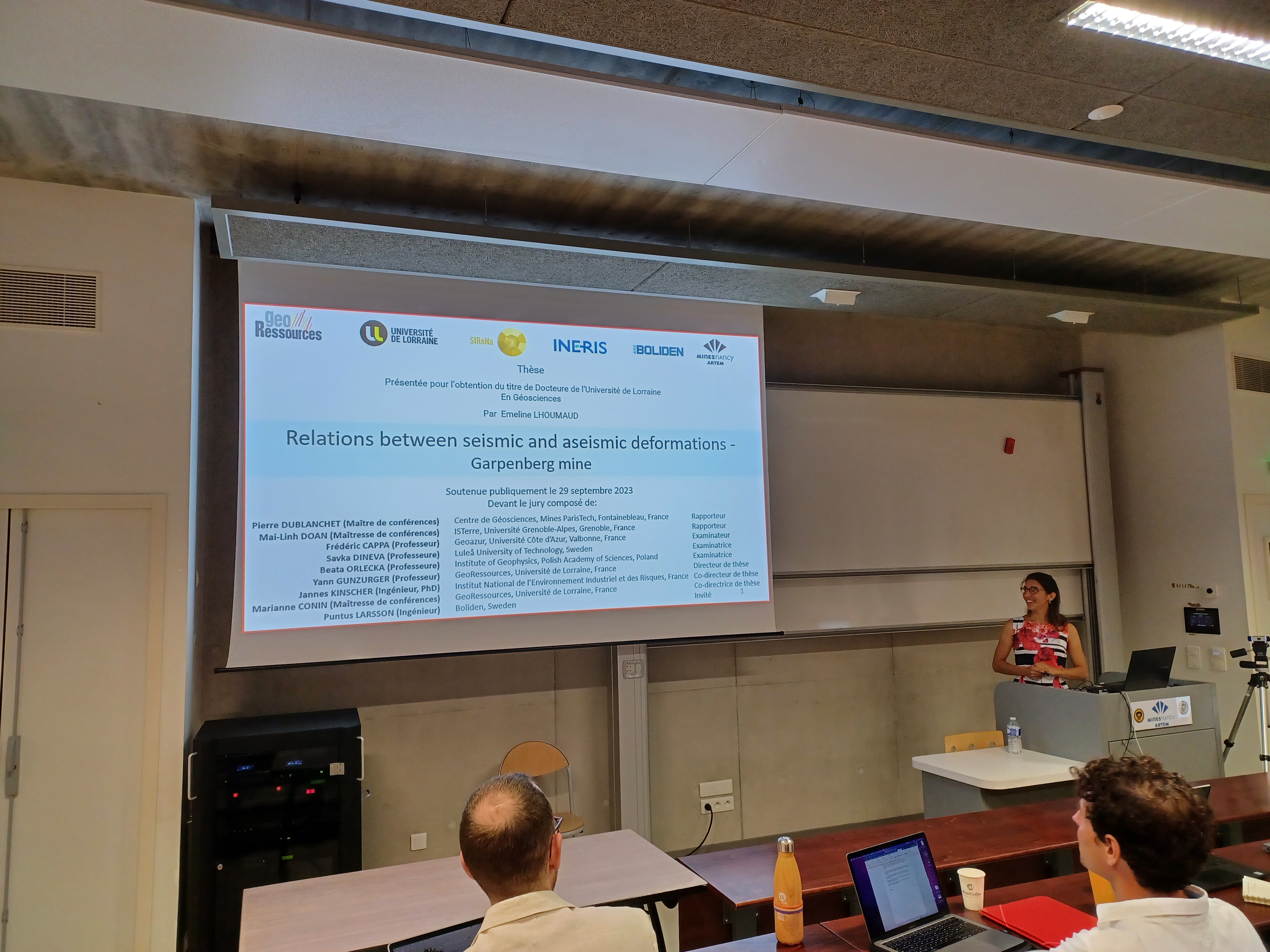Defense of a thesis co-financed by Ineris
Relationship between seismicity and aseismic deformation in a deep mine. Example of the Garpenberg mine, Sweden.
Emeline Lhoumaud was awarded the doctoral degree from the University of Lorraine on September 29, 2023, after successfully defending her thesis work conducted as part of a collaboration between Ineris and the University of Lorraine, with support from the mining company Boliden.
This thesis was carried out under the guidance of Professor Yann GUNZBURGER, a member of the GeoRessources laboratory at the University of Lorraine, and Jannes KINSCHER, a research engineer at Ineris (SIT/AS2G).
This thesis was carried out under the guidance of Professor Yann GUNZBURGER, a member of the GeoRessources laboratory at the University of Lorraine, and Jannes KINSCHER, a research engineer at Ineris (SIT/AS2G).

Thesis Defense on the Relationship Between Seismicity and Aseismic Deformations.
Thesis committee composition:
Reviewers :Ms Mai-Linh DOAN, Assistant Teacher, ISTerre, Université Grenoble-Alpes, Grenoble, France
M. Pierre DUBLANCHET, Assistant Teacher, Centre de Géosciences, Mines ParisTech, Fontainebleau, France
Jury members:
M. Frédéric CAPPA, Professor, Geoazur, Université Côte d’Azur, Valbonne, France
Ms Savka DINEVA, Professor, Luleå University of Technology, Luleå, Sweden
Ms Beata ORLECKA-SIKORA, Professor, Institute of Geophysics, Polish Academy of Sciences, Warsaw, Poland
PhD supervisor:
M. Yann GUNZBURGER, Professor, Université de Lorraine
PhD co-supervisor:
M. Jannes KINSCHER, Engineer (PhD), Ineris
PhD co-supervisor:
Ms Marianne CONIN, Assistant Teacher, Université de Lorraine
Context of the PhD:
Anthropogenic activities at depth are developing rapidly, and are confronted with ever more stringent engineering requirements in terms of risk management: mining, hydrocarbon exploitation, geothermal energy, underground storage of heat, gas, radioactive waste, etc. In particular, the increasing depth at which these projects are being developed creates geomechanical conditions that make it increasingly difficult to maintain the stability of geosystems. The overall increase in stress intensity increases the "plastic domain" generated by the mining and, concomitantly, the induced anthropogenic seismicity. The latter represents a major problem, as its origins is still poorly understood, and as it can develop at different scales and magnitudes, from micro-earthquakes to earthquakes perceived by man on the surface and capable of causing material damage.This can be achieved through interaction between geomechanical modelling, which provides a better understanding of the physical phenomena at play by testing different hypotheses, and the acquisition of in situ geotechnical (stresses, strains, pore pressure) and geophysical (induced seismicity) data. In this context, deep mines in operation, where all kinds of instrumentation are possible, can become exceptional laboratories for the observation and analysis of these phenomena.
This doctoral project follows on from F. De Santis' thesis (February 2019), conducted under an agreement between Ineris and the mining company Boliden. In this context, a deep zone (over one km deep) of the Garpenberg mine in Sweden was instrumented with various geotechnical and geophysical sensors to study the response of the rock mass to mining, combining in situ data analysis with advanced 3D numerical modeling. This thesis highlighted the complex behavior of the rock mass, characterized by different types of mechanical response. In particular, it has been shown that induced seismicity is both directly related to the excavation phasing and also influenced by the local geology. Consequently, the seismic response can be local and short-lived, as well as occurring at a distance from the excavated areas and lasting over time. Furthermore, the results of this thesis have also shown the occurrence of asismic phenomena and creep mechanisms in response to mining, which need to be better understood and analyzed.
Objectives and results of this doctoral project
The scientific objective of this doctoral thesis is to quantify the seismic and asismic response of the rock mass in response to the excavation of the Garpenberg mine in Sweden.Firstly, to understand and determine the nature of seismic asperities linked to the presence of seismic repeaters (Kinscher at al., 2019), taking into account local geological observations (structural geology) and seismic and geotechnical monitoring. Secondly, this thesis aims to study in detail the mechanical coupling between creep and seismic ruptures by combining observations from in situ monitoring and geomechanical numerical modelling.
The results of this analysis are discussed at the scale of the whole mine and of other mines in order to investigate new methods for monitoring and assessing rock burst hazards.